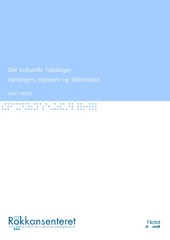| dc.contributor.author | Grove, Knut | eng |
| dc.date.accessioned | 2011-10-11T13:04:59Z | |
| dc.date.accessioned | 2020-12-10T06:33:07Z | |
| dc.date.available | 2011-10-11T13:04:59Z | |
| dc.date.available | 2020-12-10T06:33:07Z | |
| dc.date.issued | 2008-12 | eng |
| dc.identifier.issn | 1503-0946 | |
| dc.identifier.uri | https://hdl.handle.net/1956/5057 | |
| dc.description.abstract | This paper focuses on features characterizing the culture in Hardanger as part of a regional history, dealing with the period from about 1870 and forward. It is important to get hold of the characteristic features of the culture at different times through this time span. Studies of regional cultures can be seen in relation to material, social and ideological aspects. Attention must be paid to the relationship between man and nature and the conceptions concerning it, at the relationship between people and how they have arranged their activities, in hamlets, townships and organisations. Also the common belief, the ideology, is an important aspect in regard to the culture of an area or region. For this part of the regional history, the material and writings of the late folk tale collectors and historians in the area will be of great value, bringing forward common aspects and nuances in the culture along the Hardanger fjord. Thus, it is important also to trace the differences and contrasts in a region and its culture. An example is the observation of Hardanger as divided in two cultural regions, being are many cultural features resemble to those at the coast of Norway in Outer Hardanger, while features characterizing «Mountain and Fjord-Norway» («Fjell- og fjord-Noreg») are more distinct in Inner Hardanger. Differences in religious belief, to music and attitudes to celebrations and to fjord and mountain are mentioned as examples. Non-governmental and voluntary organizations and how the rise of industry lead to the development of new working cultures in Hardanger. Youth and sport organizations, local missionary societies and political parties and their recruitment range should be studied as a way of getting hold on similarities and differences in the region. In Hardanger there is possible to compare the working cultures evolving at the large factories in the industrial townships (Odda, Tyssedal and Ålvik) and the working cultures connected to the traditions of the agrarian way of life in the area. Thus, the more urban working culture at the industrial plants developed in a specific way and got local expressions, but were different at the large plants than in the local, mainly craftbased factories which were made by local initiatives, mainly by people from the region. | en_US |
| dc.description.abstract | I notatet blir trekk som karakteriserer den kulturelle fellesskapen i Hardanger og som bør handsamast i ei regionshistorie søkt løfta fram, med vekt på tida etter 1870. Det er her viktig å få grep om kva som har karakterisert kulturen i Hardanger på ulike tidspunkt innanfor dette tidsrommet, og korleis han har endra seg. Studiar av kulturelle fellestrekk bør knytast både til materielle, sosiale og tankemessige forhold. Både forholdet mellom menneske og natur og kva forestillingar som har vore rundt denne relasjonen, mot forholdet menneska i mellom og korleis dei har ordna seg i ulike fellesskap, i grend, bygd, i lag og organisasjonar er viktig å sjå på. Men også den felles forestillingsverda, ideologien, både når det gjeld religiøs innstilling og elles til kva som gjev meining i livet må handsamast. Materiale og skriftene etter folkelivsgranskarar og historikarar frå Hardanger kan her vera med på å fram både det felles og det mangefasetterte i den regionale kulturen. Det er viktig både å få grep om skilnader og motsetnader innan den regionale kulturen. Her vert det peikt på at Hardanger synest delt i to kulturregionar; der ein i Ytre Hardanger finn vi fleire fellestrekk som ligg nær ein kystkultur, medan trekk knytt til «Fjell- og fjord-Noreg» er tydelegare i Indre Hardanger. Skilnader i forholdet til religion, til fjord og fjell og til festkulturen blir her trekte fram. Som andre viktige kulturelle felt blir det vist til det frivillege organisasjonslivet og til korleis industrien førte nye arbeidarkulturar til Hardanger. Ungdoms- og idrettslag, misjonsforeiningar og politiske lag og deira utbreiing gjev inntak til å studera regionale likskapar og skilnader. I Hardanger ligg det vidare særleg godt til rette for å studera skilnader mellom arbeidarkulturen på industristadane (Odda, Tyssedal og Ålvik) med si tilhøyrsle til den nasjonale arbeidarrørsla, og arbeidarkulturen som tok utgangspunkt i dei tradisjonelle bygdenæringane og bygdekulturen. Samtidig fekk også arbeidarkulturane som utvikla seg på dei store industribedriftene spesielle uttrykk og ei lokal forankring og utforming, men var likevel annleis enn ved småbedrifter som har blitt til ut frå lokale samanhengar. | en_US |
| dc.language.iso | nno | eng |
| dc.publisher | Stein Rokkan Centre for Social Studies | eng |
| dc.relation.ispartofseries | Working Paper | en |
| dc.relation.ispartofseries | 16-2008 | en |
| dc.title | Det kulturelle Hardanger. Hardingen, regionen og fellesskapa | eng |
| dc.type | Working paper | eng |
| dc.rights.holder | Copyright Stein Rokkan Centre for Social Studies. All rights reserved | |
| dc.description.version | publishedVersion | |
| dc.subject.nsi | VDP::Samfunnsvitenskap: 200 | nob |
